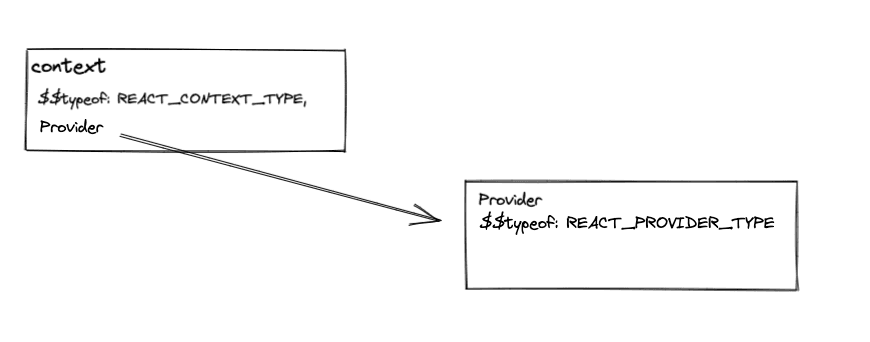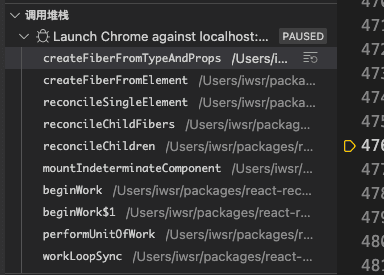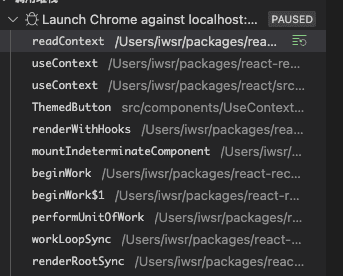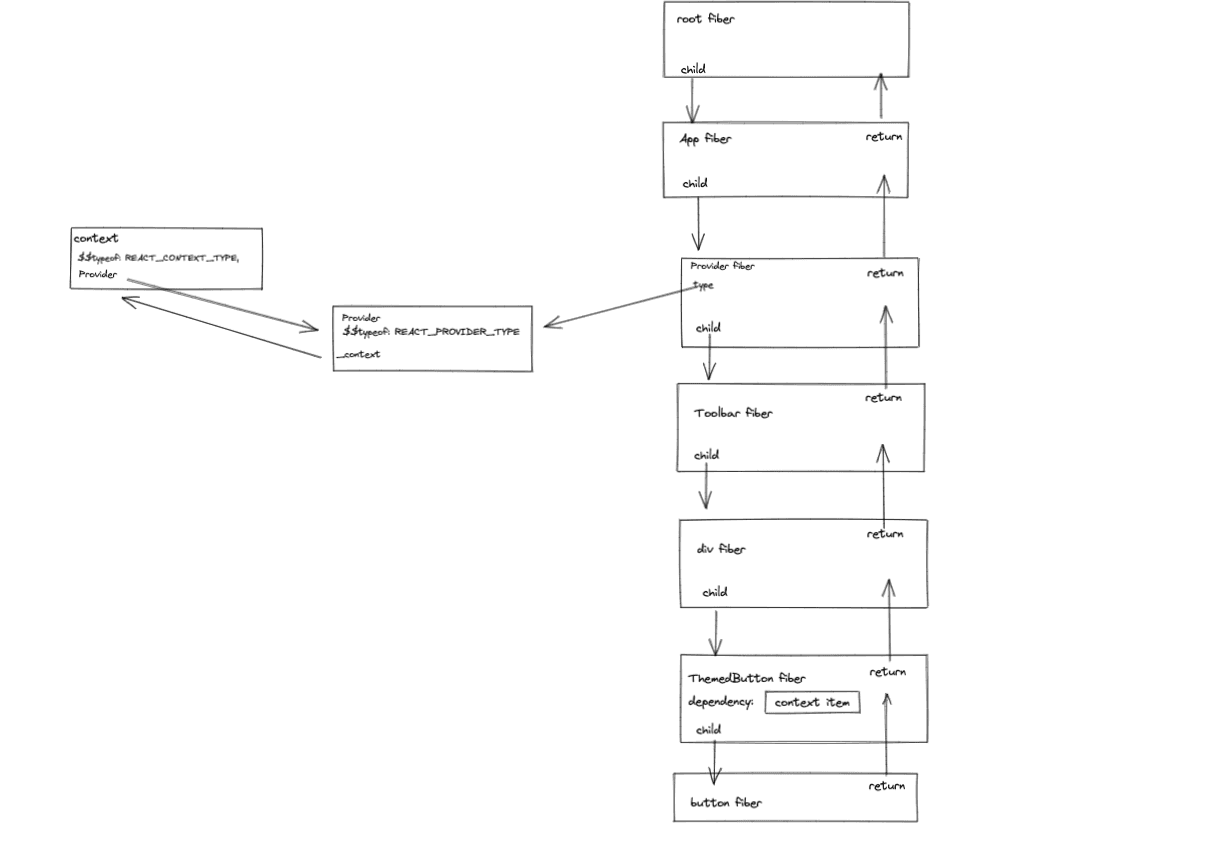說明#
- 本文重點將會分析 React 內的 Context 機制,分為三個小階段
- createContext
- context.Provider
- useContext
- demo 基於官方例子
const themes = {
light: {
foreground: "#000000",
background: "#eeeeee"
},
dark: {
foreground: "#ffffff",
background: "#222222"
}
};
const ThemeContext = React.createContext(themes.light);
function App() {
return (
<ThemeContext.Provider value={themes.dark}>
<Toolbar />
</ThemeContext.Provider>
);
}
function Toolbar(props) {
return (
<div>
<ThemedButton />
</div>
);
}
function ThemedButton() {
const theme = useContext(ThemeContext);
return (
<button style={{ background: theme.background, color: theme.foreground }}>
我是由主題上下文樣式化的!
</button>
);
}
createContext#
直接對 createContext 打上斷點,
export function createContext<T>(defaultValue: T): ReactContext<T> {
/**
* 聲明了一個 context
*/
const context: ReactContext<T> = {
$$typeof: REACT_CONTEXT_TYPE,
_currentValue: defaultValue,
_currentValue2: defaultValue,
_threadCount: 0,
// These are circular
Provider: (null: any),
Consumer: (null: any),
// Add these to use same hidden class in VM as ServerContext
_defaultValue: (null: any),
_globalName: (null: any),
};
/**
* beginWork 創建 fiber 時會根據 $$typeof 來分別處理
*/
context.Provider = {
$$typeof: REACT_PROVIDER_TYPE,
_context: context,
};
let hasWarnedAboutUsingNestedContextConsumers = false;
let hasWarnedAboutUsingConsumerProvider = false;
let hasWarnedAboutDisplayNameOnConsumer = false;
context.Consumer = context;
return context;
}
東西不多,內部主要是聲明了一個 context 對象,並在上面掛上了 Provider 的屬性。

接下來看看 provider 裡面是怎麼處理的
context.Provider#
仔細看 demo 裡面用到 Provider 的地方,能發現它是被以 jsx 的方式使用到程序內的。
那麼調試的思路也很明顯了,去觀察 beginWork 內生成 fiber 的地方
對 App 的 return 打點,會進入以下調用棧

在 createFiberFromTypeAndProps 內會先將 ContextProvider 賦值給 fiberTag,以表示我需要創建一個 Provider 特供的 fiber 節點,然後進入 createFiber,隨後便返回了一個 type 為 ContextProvider 的 fiber 節點。

需要注意的是此時我們還在 App 的 beginWork 內,如果需要觀察 ContextProvider 的,需要進入下一次 beginWork。

這裡才是正式處理 ContextProvider 的地方。
function updateContextProvider(
current: Fiber | null,
workInProgress: Fiber,
renderLanes: Lanes,
) {
const providerType: ReactProviderType<any> = workInProgress.type;
// createContext 創建的 context 對象
const context: ReactContext<any> = providerType._context;
const newProps = workInProgress.pendingProps;
const oldProps = workInProgress.memoizedProps;
const newValue = newProps.value;
// 這裡修改了 context 的 _currentValue為新值
pushProvider(workInProgress, context, newValue);
if (oldProps !== null) {
const oldValue = oldProps.value;
// provider 比較 value前後是否發生變化
if (is(oldValue, newValue)) {
// No change. Bailout early if children are the same.
// 沒有改變的話,並且 children 未更新就復用原來的 fiber 然後退出
if (
oldProps.children === newProps.children &&
!hasLegacyContextChanged()
) {
return bailoutOnAlreadyFinishedWork(
current,
workInProgress,
renderLanes,
);
}
} else {
// 如果前後 value 不同,那麼就更新所有 consumers
// 這裡暫時先不展開,等到 useContext 時再介紹
// The context value changed. Search for matching consumers and schedule
// them to update.
propagateContextChange(workInProgress, context, renderLanes);
}
}
// 繼續創建 provider 的子節點
const newChildren = newProps.children;
reconcileChildren(current, workInProgress, newChildren, renderLanes);
return workInProgress.child;
}
updateContextProvider 的思路也比較簡單,修改 context 內的 value 後比較新舊值是否相等,相等就復用 fiber 節點,不相等就重新創建新的 fiber 節點。唯獨需要注意的地方是 propagateContextChange。這個我們會結合 useContext 一塊講。
useContext#
令人高興的是,這個 hook 並不需要分 mount 與 update 來講。並且也不會生成 hook 對象。

我們直接來看 readContext 裡面做了什麼就行了。
因為使用這個 hook 時需要傳入對應的 context 對象
const theme = useContext(ThemeContext);
export function readContext<T>(context: ReactContext<T>): T {
/**
* 獲取 context 傳入的 value
* */
const value = isPrimaryRenderer
? context._currentValue
: context._currentValue2;
if (lastFullyObservedContext === context) {
// Nothing to do. We already observe everything in this context.
} else {
// 創建了一個 contextItem,後面會穿成鏈表掛在目前正在渲染的 fiber 節點上
const contextItem = {
context: ((context: any): ReactContext<mixed>),
memoizedValue: value,
next: null,
};
if (lastContextDependency === null) {
// 創建鏈表,並掛載在 fiber 節點上
// This is the first dependency for this component. Create a new list.
lastContextDependency = contextItem;
currentlyRenderingFiber.dependencies = {
lanes: NoLanes,
firstContext: contextItem,
};
if (enableLazyContextPropagation) {
currentlyRenderingFiber.flags |= NeedsPropagation;
}
} else {
// Append a new context item.
// 在 fiber 上的 context item 鏈表上加元素
lastContextDependency = lastContextDependency.next = contextItem;
}
}
// 把值丟出去
return value;
}
此時大致上就是這麼個結構了

readContext 主要做的還是讀取傳入 context 內的值,但是為什麼要在當前渲染的 fiber 節點上增加一個與 context 相關的鏈表呢?
這時需要回過頭看看 propagateContextChange 了
function propagateContextChange_eager(workInProgress, context, renderLanes) {
var fiber = workInProgress.child;
if (fiber !== null) {
// Set the return pointer of the child to the work-in-progress fiber.
// 給子節點綁定 父節點
fiber.return = workInProgress;
}
while (fiber !== null) {
var nextFiber = void 0; // Visit this fiber.
/**
* fiber 節點上的 dependencies 在這裡被視為了內部存在使用了 context 的標識
*/
var list = fiber.dependencies;
if (list !== null) {
// 這裡是有使用到 context 的場景
nextFiber = fiber.child;
var dependency = list.firstContext;
/**
* 這裡通過 while 遍歷 context item 的鏈表確認是否存在當前 provider 上綁定的context 對象
*/
while (dependency !== null) {
// Check if the context matches.
if (dependency.context === context) {
// 找到了有使用到當前 provider 上標記的 context 對象
// Match! Schedule an update on this fiber.
if (fiber.tag === ClassComponent) {
...
}
// 給當前 fiber 標記上更新標識
fiber.lanes = mergeLanes(fiber.lanes, renderLanes);
var alternate = fiber.alternate;
// 同樣也需要給當前 WIP 對應的 current 節點也打上相同的標記,防止被更高優先級任務插隊後丟失信息
if (alternate !== null) {
alternate.lanes = mergeLanes(alternate.lanes, renderLanes);
}
/**
* 這裡在別的文章裡也多次提到過類似的操作(比如 useState)
* 其實就是模擬了生成了一個 renderlanes 的 update
* 將更新從當前節點一直向上標記,直到 root 節點。
* 從而在調度時一起更新
*/
scheduleContextWorkOnParentPath(fiber.return, renderLanes, workInProgress); // Mark the updated lanes on the list, too.
list.lanes = mergeLanes(list.lanes, renderLanes); // Since we already found a match, we can stop traversing the
// dependency list.
break;
}
dependency = dependency.next;
}
} else if (fiber.tag === ContextProvider) {
...
} else if (fiber.tag === DehydratedFragment) {
...
} else {
...
}
...
}
fiber = nextFiber;
}
}

大致總結一下便是,每一個使用到了 context 對象的 fiber 節點都會被打上 dependencies 的鏈表屬性,一旦 provider 上的 value 發生改變,它就會遍歷自己的所有子節點是否擁有 dependencies 的標記,並給他們打上更新標記從而實現強制更新。就像文檔裡說的一樣。
